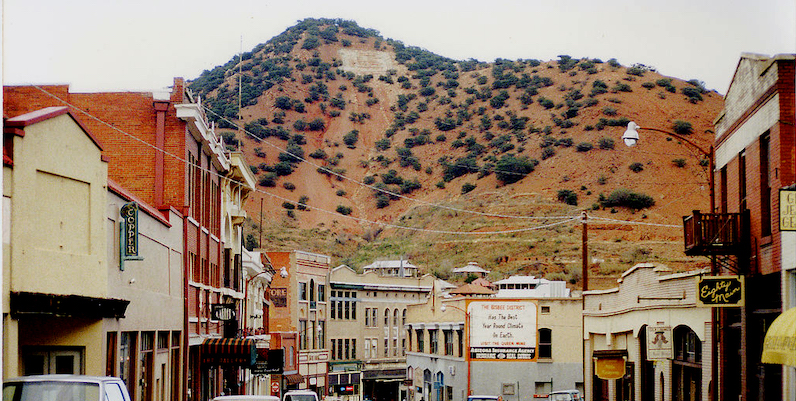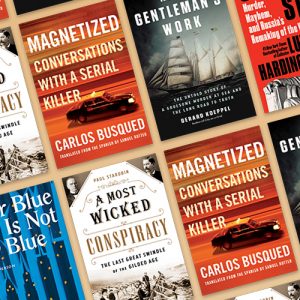I grew up in Bisbee, Arizona, a small mining town near the Mexican border. Between us and the rest of the country to the north lay the Mule Mountains, with a pass known as the Divide. It took a long time for television to make it over the Divide and down into our town, so in the fifties and early-sixties, the only path out to the rest of the world was a two-lane road called Highway 80. It was either follow Highway 80 or read books. I chose the latter.
My first experience with crime fiction as a grade-schooler was, unsurprisingly, Carolyn Keene’s Nancy Drew. Nancy was all the things I wanted to be—smart, brave, sophisticated, and able to solve complicated crimes. She also drove a bright red roadster. Might she be the reason there’s a bright red Porsche Boxster out in our garage? I don’t know. You be the judge.
There was no bookstore per se in Bisbee. What was readily available to me were the paperbacks on the book carousels in our corner drugstore, Warren Drug. I don’t know which was the first John D. McDonald that came to hand, but I remember that the titles all had colors in them. A Tan and Sandy Silence is the one that comes readily to mind, but what fascinated me about the Travis Magee books was the setting in Florida. As a kid from the desert, I was astonished that someone actually lived on a boat—the Busted Flush. And were there really enough seashells in the world that you could use them to build a road the same way we used gravel on Yuma Trail in Bisbee? According to Travis Magee, Florida was a magical, livable, exciting place. Somehow the books neglected to tell me about the heat and humidity. I grew up in the desert and heard all the dry heat jokes, but it wasn’t until I was an adult and went to Florida for the first time that I learned those words really aren’t funny.
My high school librarian, Mrs. Philippi, steered me into the works of Mary Stewart and Nora Lofts, but it was Daphne DuMaurier who kept me utterly enthralled with My Cousin Rachel and Rebecca. Reading her books taught me about life in Cornwall—a place almost as foreign to an Arizona desert rat as Mars would be. It was in her books that I first encountered high teas and the term “rashers of bacon.” I grew up in a family of nine. When it came to breakfast everyone got a single slice of bacon. Florida’s heat didn’t come through in John D. McDonald’s books, and rashers of bacon didn’t translate well for me, either. To my way of thinking, a rasher of bacon had to be nothing short of a whole platter of same rather than a single slice. I know better now, but somehow I still like the picture those books imprinted in my mind’s eye.
To Kill a Mockingbird came out in 1960, while I was still in high school. Yes, it’s a classic now, but it was also crime fiction that dealt with the very real racial prejudices that were completely beyond the ken of someone growing up in an isolated Arizona copper mining town. There were very few black people living in town, and somehow I failed to make the connection between the Anglo/Hispanic prejudices that were part of everyday life in Bisbee and what was going on in places like Georgia and Mississippi. Reading To Kill a Mockingbird did a lot to open my eyes on that score.
At this point in my life, I’m still thrilled when other people’s books take me to places I don’t know personally. I feel as though I have come to know and love North Carolina through Ann B. Ross’s Miss Julia books. If Carolyn Keene had let Nancy Drew grow up and age into a dowager, she would have turned out to be just like Miss Julia. I’ve never been to Botswana, but Alexander McCall Smith’s Precious Ramotswe in the No. 1 Ladies’ Detective Agency books has taught me about the old ways and traditions of Botswana and, if I’m not sadly mistaken, there’s a box Red Bush Tea hiding in our cupboard this very moment.
***
I’d like to add a final note about growing up in Bisbee, Arizona. Published in the mid-seventies, Bisbee ’17 is about what locals call the “Bisbee Deportation.” It’s one of those historical issues that can still cause fist-fights to break out in Brewery Gulch on occasion. The town came to life in the late 1800s as a copper mining camp, and miners from all over the world—Mexico, Cornwall, Wales, Serbia, and Croatia—came to work in Bisbee’s underground mines. In 1917, with World War I in progress, Bisbee was the site of a huge copper strike. There was a big discrepancy between what was paid to native-born miners as opposed to immigrant miners. When unionized workers threatened to strike, asking for equal wages for equal work, company execs claimed it was a way of undermining the war effort. They handed out weapons to all their non-union personnel and used them to round up the union guys who were herded through the streets to the Warren Ballpark, where they were loaded onto a train and hauled out to a spot near Columbus, New Mexico, and summarily dropped off. Some of them returned to Bisbee. Many did not.
Once the “deportation” was over, the mining company gathered up the weapons and put them in a safe in the company store. When the mines shut down for good in the mid-nineteen-seventies, someone opened the safe and discovered all those guns were still inside. They were handed out on a first-come, first-served basis, and that’s how one of those old Colts turned up as a murder weapon in one of my Joanna Brady books, Exit Wounds.
(By the way, there’s a movie version of Bisbee ’17 streaming on video right now. In my opinion, the book is better than the movie. Isn’t that usually the case?)
Another Bisbee book still resonates. In the early-nineties, charged with writing my second Joanna Brady book, I encountered a serious case of writer’s block. Telling myself I was doing research, I picked up a copy of Richard Shelton’s memoir of his time in my hometown called Going Back to Bisbee. Shelton had ended up in southeastern Arizona as a soldier stationed at Fort Huachuca. Later, he came to Bisbee as a beginning teacher at Bisbee’s Lowell School.
In his book he wrote about being surprised at the amount of prejudice he encountered in the town’s social circles. As a teacher, he was considered a white-collar worker and was expected to hobnob with the doctors, lawyers, CPAs, and company executives in town. His interactions with the mine workers who were the fathers of his students were limited to school functions—mostly athletic or PTA events. There was a wide white-collar/brown-collar gap in town, and one crossed it at your peril.
In reading his description of that barrier I suddenly decoded an important aspect of my own life. My father was a farmer before we moved to Bisbee, where he immediately went to work underground. For a time, he worked in the mines. Later, he and a partner started a general construction company and a cement plants. Then, when I was in seventh grade, my father sold out his interests in those two ventures and went to work selling life insurance. Suddenly he was transformed into a tie-wearing, white collar worker—a professional who joined Kiwanis and hung out with … well … the doctors, lawyers, CPAs, and company execs, a reality that left his children in a kind of social limbo. The upscale kids looked down their noses at us, and the other kids in town didn’t trust us anymore. There’s nothing like becoming a teenaged outsider to turn someone into first an observer and eventually into a writer.
In reading Richard Shelton’s book decades later, I really did unlock much of my own history, but while I was growing up in Bisbee’s mountain fastness, reading opened up the rest of the world for me. More than a hundred years after the Bisbee Deportation, in the midst of Covid 19’s four-wall isolation, reading is keeping me sane.


















